Our top 10 non-toxic crib list features baby beds that are VOC-free, won’t off-gas, and that are made sustainably with respect for the environment. We’ve chosen good quality cribs at every price point.
Table of Contents
When I was a new mom, I made a point of avoiding products that off-gas. Thankfully, breaking the bank is unnecessary to get a truly eco-friendly crib.
In this article, I’ll look at the best companies making non-toxic, eco-friendly cribs, and list a few runners-up. The bottom line for me here is sustainable, non-toxic materials. I’ll share the pros and cons of many popular options and explain why my top choice for a low-cost crib is the IKEA Sniglar.
Also, check out my research on the most important crib certifications.
Hardwood vs. softwood cribs
The safest sleeping surface for a baby is a 100% hardwood crib with a food-grade finish such as linseed oil, preferably made either without glue or with soy- or water-based glue. For top marks, you want a crib without composite wood (no MDF, plywood, etc.), laminates, paints, stains, or adhesives that contain formaldehyde and other VOCs.
Sadly, for many, these hardwood cribs are either too costly or inconvenient to purchase. But don’t despair. There are some fantastic softwood cribs available.
Softwood cribs have pros and cons. Pine, poplar, beech, and other softwoods are lighter and make for a cheaper crib than hardwoods. However, they are more easily dinged and scratched and may not be robust enough to be reused, making them less eco-friendly and cost-effective than a durable hardwood crib.
Still, if you’re on a budget and only planning on having one child, a softwood crib might be perfect for you.
Free eBook: Simple Steps to a Greener Home
Concerned about climate change? Learn actionable tips for making each room in your home greener.
"*" indicates required fields
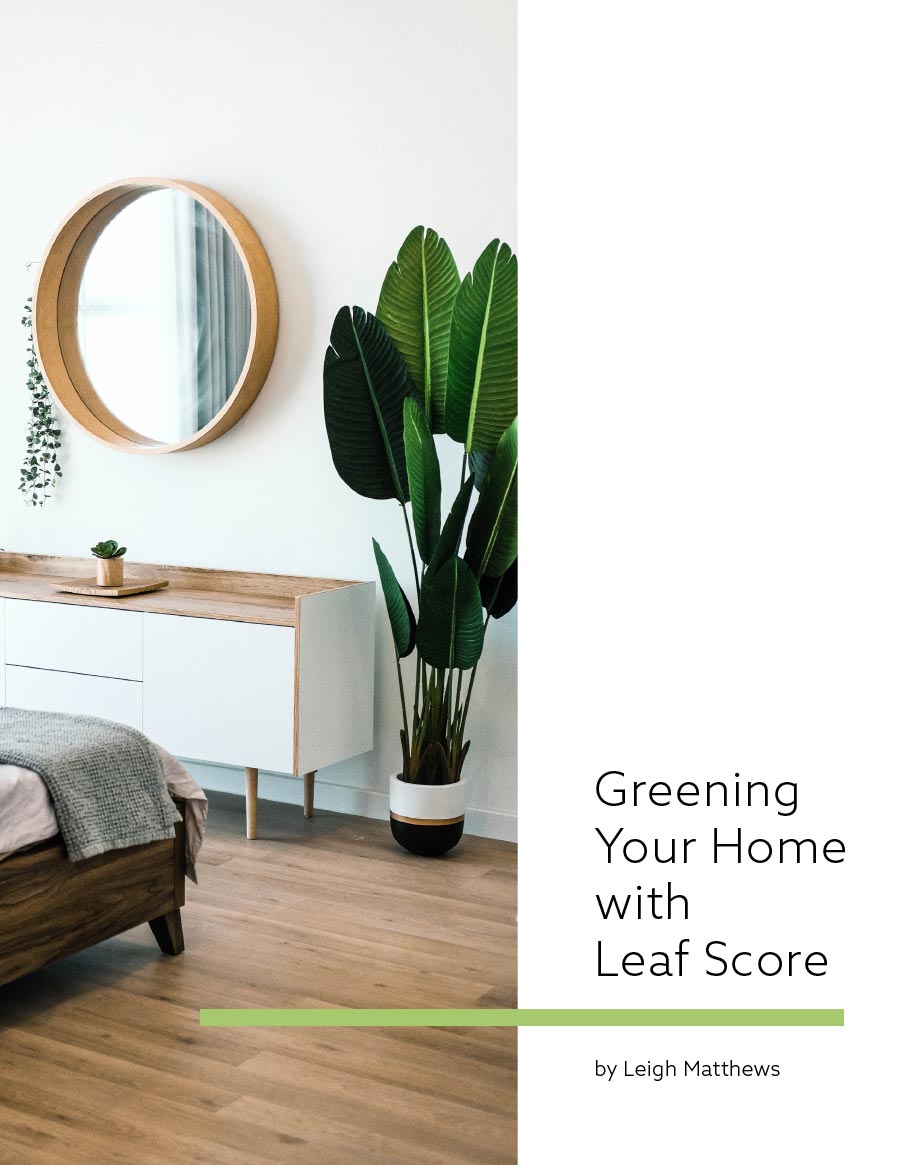
The best sustainable, VOC-free cribs: our top picks
Let’s get to our top picks.
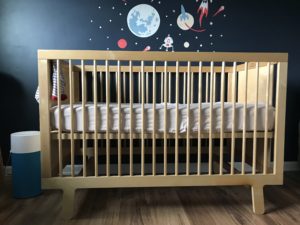
Oeuf Sparrow Crib [Staff tested]
Highlights: Our top choice for an eco-friendly, non-toxic crib that can convert to a toddler bed. Easy assembly, durable, and sustainable.
- Sustainably made in Europe in an eco-friendly facility
- Family-run company
- Greenguard Gold certified
- FSC certified solid birch and FSC certified Baltic Birch plywood
- Converts to toddler bed
- Oeuf uses only non-toxic finishes and glues
- Three mattress positions
- Holds up well for use by several babies
- Expensive
Crib Type: Softwood
I love the aesthetic of the Oeuf Sparrow Crib and was very happy to find one secondhand at a fraction of the cost new. The design is simple, clean, and modern, making for easy cleaning and assembly.
Some of the original hardware was missing from my crib, so I contacted Oeuf for replacements. This was easy and the customer service was great.
Despite having already served at least two babies, the Sparrow was in great shape, with no obvious tooth marks or dings. It also held up very well to my toddler and is now in storage for round two (should that happen!).
I love knowing that this crib is non-toxic and eco-friendly (check out Oeuf’s sustainability practices in my full review). It was also really great for me as a shorter person who struggles to reach waaaaaay down into a deep crib.
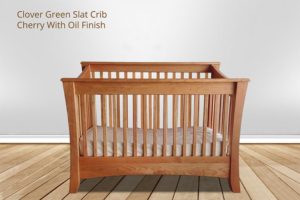
Green Cradle
Highlights: Scrupulous safety standards, beautiful designs, and impeccable materials.
- Solid hardwood
- Eco-conscious brand
- Many finishes to choose from
- Expensive
- Slow delivery time
Crib Type: Hardwood
One company consistently earns top marks from eco-minded parents for their hardwood, non-toxic cribs: Green Cradle. This brand strives for total transparency and specializes in making organic and all-natural products without toxic chemicals. Green Cradle cribs start at around $1,545 and go up to around $4,400 for the most expensive model in the priciest hardwood (walnut). It includes an organic natural latex crib mattress and all the accessories to convert the crib into a toddler bed, day bed, and full bed.
Most Green Cradle cribs offer adjustable mattress positions and are free of composite wood products. Instead, they’re made with 100% solid red oak, brown maple, hard maple, walnut, or cherry hardwoods. All finishes are food-safe, compostable, 100% VOC-free (not low-VOC like many competitors), and hand-rubbed onto the wood three times. Green Cradle doesn’t use any chemical preservatives, has high environmental standards, and claims to be carbon neutral.
Green Cradle offers free shipping on all orders throughout the contiguous US over $500, although state taxes may also apply depending on where you live. Most models ship within 11-12 weeks of order, and there is an optional ‘rush order’ upgrade to get your crib shipped in 7-8 weeks for an additional cost.
If I had the money and lived closer to Sherman Oaks, California, a Green Cradle crib would be my top choice for an eco-friendly crib. I’d probably also be buying their clothing, mattresses, bedding, toys, organic and natural health and body care, and furniture. Shipping a hardwood crib to Canada seems rather silly, however, and far from eco-friendly, so I’ll go with something built closer to home from local wood or something shipped en masse to a nearby store.
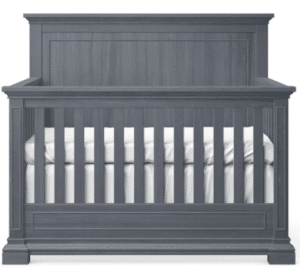
- Solid hardwood
- Multiple crib designs to choose from
- Made with European materials
- Not Greenguard Gold certified
- Lower price point than comparable cribs
Crib Type: Hardwood
Silva is a sister brand to Romina (more on them below). The company makes similarly high-end cribs and other furniture but without the Greenguard Gold certification. Even so, the company adheres to the same principles of using only safe, healthy materials and non-toxic chemicals in finishes and glues. Better yet, the cost of certification isn’t absorbed into the products, so all of the cribs from Silva cost just $1,095, compared to around $1,500 minimum for Romina cribs.
Silva currently offers four crib designs: Serena, Edison, Jackson, and Jordan, all for $1,095. These cribs are convertible into a toddler bed, day bed, and full-size bed, although conversion kits and toddler guard rails must be bought separately.
Like Romina, Silva cribs are made in Romania, using European materials. Similarly, they are made from beechwood, contain non-toxic, organic, no-VOC finishes, and use dovetailed drawer designs and mortise and tenon joints. They also employ Romina’s soft-closing drawer system that avoids fingers getting caught and use drawer ‘triggers’ to prevent the drawers from being opened by little fingers.
There is one other difference (aside from certification) between Silva and Romina. The former has fewer designs and fewer customization options. If you’ve got ‘menu fatigue,’ though, this might be a good thing.
It might seem counterintuitive in an article on the best eco-friendly, non-toxic cribs to give my top recommendation to a crib without any eco-certifications, but I feel pretty darned confident that Silva, as an off-shoot of Romina, is a solid bet for a safe, healthy, and slightly cheaper hardwood crib.
If you’re looking to purchase a softwood crib for around $1,000 and plan on having more than one child or would like to pass the crib on, Silva is worth it. You can find Silva cribs at more than 60 retailers across the US, Canada, and elsewhere.
Yes, it would be preferable to buy a crib made closer to home from local BC timber (in my case), but I take some solace in the fact that Silva ships to at least one store near Vancouver (Richmond, BC), meaning that there’s a modicum of energy efficiency involved in getting the crib when it’s time.
Free eBook: Simple Steps to a Greener Home
Concerned about climate change? Learn actionable tips for making each room in your home greener.
"*" indicates required fields

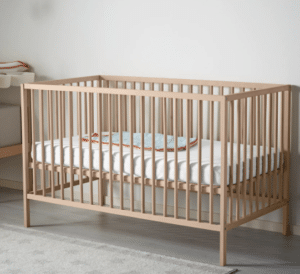
Ikea Sniglar
Highlights: One of the best budget options you can find without toxic finishes or stains.
- Low cost
- Made without MDF
- Softwood
- Often out of stock
Crib Type: Softwood
If I were a little taller, Ikea’s Sniglar would be my favorite budget crib option. It costs just $119 and can easily be converted into a toddler bed. The Sniglar used to be made with a combination of beechwood and an undesirable MDF mattress base. Thankfully, Ikea responded to customer concerns and now makes the entire crib with unfinished beechwood – no nasty toxic finishes or stains.
Note: The Ikea Sundvik and Gulliver cribs are very similar to the Sniglar, but both are made with beech and fiberboard, so beware.
One downside to the Sniglar is that it only has two mattress height options, meaning it’s not ideal for those 5’3″ and under or those who have difficulty reaching down to lift out an infant. Another drawback is its popularity; it frequently goes out of stock at Ikea! So, don’t rely on this as a last-minute option if your more expensive crib hasn’t shown up in time.
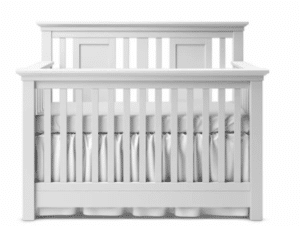
Romina
Highlights: Top choice if you have the money and an eye for design and customization
- Solid hardwood
- Greenguard Gold Certified
- More expensive than other options
Crib Type: Hardwood
Romina clearly has a passion for building beautiful cribs and other safe, durable, and desirable furniture. It’s a family-owned business established in 1991 that aims to build on woodworking traditions passed down over three generations. Romina first sold furniture in the US in 2006, and now has more than 85 retailers in the US, Canada, and elsewhere in the world. You can buy a Romina crib online or find an authorized specialty store in the US or Canada using their “Find a Store” tool.
This Romanian company makes cribs from 100% solid hardwood, organic glues, and non-toxic, water-based, organic oil finishes (free of VOCs, lead, and formaldehyde). Even better, all of Romina’s furniture is GreenGuard Gold Certified. Cribs meet and exceed CPSC standards and range from $1,200-$1,795 or more.
Romina offers a variety of stylish cribs that can be converted into toddler beds, day beds, and full beds. These cribs come with a 3-year warranty, and the company makes it really easy to order any replacement parts or conversion accessories through the website.
I like that Romina has complete control over its production facilities in Europe, which means they know exactly how each crib is made. They also design and make other beautiful furniture, meaning that you could kit out your whole nursery (even your whole house) with Romina products.
One downside is that all of the cribs seem to have metal mattress supports, which may mean some sagging once your child is older and heavier. If their cribs had wooden slat supports, Romina cribs would be my top choice for a safe, eco-friendly, non-toxic crib.
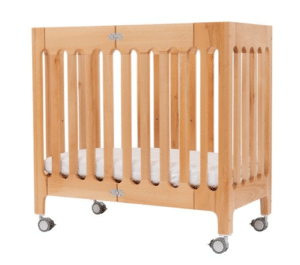
Bloom Mini Crib
Highlights: Foldable, easily stored, made with solid wood, and free of lead, BPA, phthalates, and other toxins.
- Solid hardwood
- Ideal for small spaces
- Easily foldable
- May be too small for daily use
Crib Type: Hardwood
My favorite mini crib option is the Bloom Mini Crib, which is made with solid wood and low-VOC baby-safe finishes. It’s MDF-free, lead-free, BPA-free, phthalate-free, and formaldehyde-free. This crib is also foldable, easily stored, requires no tools for set-up (which takes just 5 minutes), and can turn your hallway closet into a convenient nursery if you’re pushed for space. It’s also available in a really lovely green color, perfect for any eco-friendly nursery aesthetic.
Bonus: it costs just $529.
Free eBook: Simple Steps to a Greener Home
Concerned about climate change? Learn actionable tips for making each room in your home greener.
"*" indicates required fields

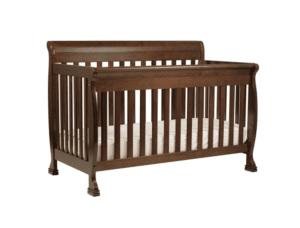
DaVinci Kalani 4-in-1 Crib
Highlights: Inexpensive while still maintaining sturdiness compared to its competitors in a similar price range.
- Greenguard Gold certified
- Multiple color options
- Surprisingly durable
- Softwood
Crib Type: Softwood
The DaVinci Kalani 4-in-1 Crib is my overall top pick for a softwood crib. It is both inexpensive and sturdy, which is a rare combination. The crib is made with sustainably sourced New Zealand pine wood, is Greenguard Gold Certified, looks great, and is durable enough to last through multiple babies. It has been a bestseller for DaVinci for more than ten years and is a Wirecutter and Consumer Reports top pick, so I’m not alone in extolling its virtues. The crib is available in rich cherry, chestnut, ebony, espresso, grey, honey oak, and white, which means you’re bound to find a color that matches the aesthetic of your nursery.
The 4-in-1 nature of the crib means that it can be conveniently converted to a toddler bed, day bed, and then a full-sized bed to meet your child’s needs (and save you money) as they grow. Reviewers seem to agree that it’s incredibly durable, which is a bit of a rarity in this price range. It’s also widely available and easy to order, which is not true of some of the other hardwood cribs on this list.
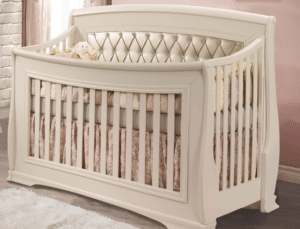
- Wide price range for multiple budgets
- Hardwood
- Not suitable for vegans
- Brand doesn’t explicitly state if VOC-free
Crib Type: Hardwood
Natart Juvenile makes Greenguard Gold Certified cribs ranging from around $699-$1,700. These solid wood cribs are made in Canada with beechwood, oak, or birch, and use solid wood mattress supports. Natart offers a range of styles, including both contemporary modern and classic curved designs. Most models convert into toddler beds, with some 5-in-1 models converting into a toddler bed, daybed, double bed headboard and complete double bed.
Natart Furniture is a small family-owned company founded in Rome in 1988 as an adult furniture manufacturer. The company relocated to Quebec, Canada, in 1995, and launched their juvenile division in 2001. They added their Tulip Juvenile line of modern furniture in 2008, and in 2014 added Nest Juvenile and Natart Gliders to their kid’s collection (see more below on Nest and Tulip).
The cribs, as with all Natart Juvenile furniture, have a full bottom dust cover. They also have anti-tip hardware (which features a leather strap), and some models are upholstered with a choice of leather or washable fabric. So, if you’re vegan like me, these cribs might not be quite right for you and your baby, unless you’re willing to install your own anti-tip system.
I love that these cribs have solid wooden slat mattress supports instead of metal, and I appreciate that Natart lists the broad range of certifications they carry for their products, including Greenguard Gold certification, and 16 CFR Part 1303 – Ban of Lead-Containing Paint and Certain Consumer Products Bearing Lead-Containing Paint, as well as California’s Proposition 65 for Phthalates, and the Illinois Lead Poisoning Prevention Act. All cribs adhere to required CPSC and ASTM standards, as well as Health Canada standards.
I wish Natart would explicitly state that they don’t and won’t use any VOCs or other toxic chemicals in their products, as they only say that they use ‘low-VOC’ materials. Still, as cribs go, Natart Juvenile is a great option for a solid wood crib with excellent certification.
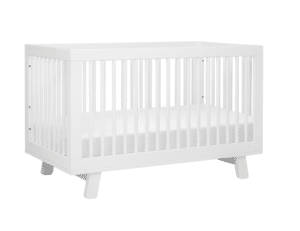
Babyletto 3-in-1 Cribs
Highlights: An attractive design made from natural pine that’s Greenguard Gold Certified.
- Greenguard gold certified
- Multiple color options
- Budget-friendly price point
- softwood
Crib Type: Softwood
Babyletto’s 3-in-1 Lolly Crib is my favorite crib in terms of design, thanks to its contrasting natural pine spindles and frame that can be white, black, or grey. It has rounded edges and tapered, peg-like feet. Like the Kalani, the Lolly is made with pine, is Greenguard Gold Certified, has four adjustable mattress positions, and can be converted into a toddler bed and a day bed, but not a full-size bed. At around $500 (which includes the conversion toddler rail), the Lolly is quite a bit more than the DaVinci Kalani, though.
Babyletto’s 3-in-1 Hudson Crib is another good option for a softwood crib and is also available in two-tones, as well as white, grey, and a blush pink. This design has angled legs and round spindles, is also made with pine, has four adjustable mattress positions, and can be converted into a toddler bed and a day bed, but not a full-size bed. It costs around $499 at Target currently.
Babyletto’s Modo 3-in-1 Crib is similar in price to the Kalani, priced at $329 on Amazon currently, depending on your color choices (this includes the toddler rail for conversion). This model is Greenguard Gold Certified, made with New Zealand pine, and can be converted to a toddler bed or day bed. It has four adjustable mattress positions and has a more ‘blocky’ appearance, with straight legs and bars instead of spindles.
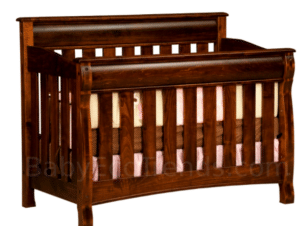
Baby Eco Trends
Highlights: Beautiful hardwood furniture made by Amish craftsmen (but be careful of the finishes)
- Made USA
- Kiln-dried wood, no glue
- Optional accessories like a changing table
- No eco-certifications
- Expensive compared to similar cribs
Crib Type: Hardwood
Baby Eco Trends is an excellent option for solid hardwood bassinets, cradles, and cribs. These cribs are handmade in Ohio by Amish craftsmen using solid wood sustainably harvested in the US and can be delivered anywhere in the contiguous US. The wood is kiln-dried rather than chemically treated, and the craftsmen use mortise and tenon joints rather than glue.
So, while it’s a shame that the company doesn’t carry any eco-certifications or Greenguard Gold Certification, it’s a pretty safe bet that their cribs are non-toxic simply because they don’t use glues. That said, because you can choose to have the crib treated with standard or formaldehyde-free finish or paint, some toxic chemicals may be knocking around in the factory where the cribs are made. Make sure you choose a formaldehyde-free finish or paint to keep your crib non-toxic and eco-friendly.
Prices range from $1,800 to $2,700, with almost all cribs able to be converted into a toddler bed, day bed, and full bed. They also offer low-profile (low-rise) cribs, which are great if you’re a little shorter (like me!) and find it hard to reach down low into a crib. Most Baby Eco Trends cribs also have three adjustable mattress positions, so you can have newborns up high, older infants a little lower, and potential escapees on the lowest setting. Cribs fit standard baby crib mattresses and comply with all required standards (CPSC, ASTM), in addition to being third-party lab tested and approved.
Some models have an optional Baby Changing Tray that attaches to matching Dressers / Baby Changers for extra security and can easily be removed when no longer needed. You can also choose custom stains, finishes, paints, and hardware, as well as other wood varieties by emailing the company. To make sure your new crib has the right aesthetic, you can request samples of hardwood and stain/paint selections (for a price, refundable upon return of the samples).
Cribs take around 8-12 weeks to complete, plus packing and shipping time. Free curbside delivery is available, and assembly instructions are provided.
Free eBook: Simple Steps to a Greener Home
Concerned about climate change? Learn actionable tips for making each room in your home greener.
"*" indicates required fields

Final thoughts on the best non-toxic cribs
I’ve listed a lot of brands and products in this article, which I hope means there’s something to suit every growing family. For a budget-friendly option, Ikea’s Sniglar crib is the clear winner. And, in the mid-range, through a combination of cost, design, and safety, Silva gets my seal of approval.
I lucked out when I needed a new crib, finding a secondhand Oeuf Sparrow Crib at a fraction of the cost new. If I hadn’t snagged that bargain, I would have gotten the Sniglar. As it is, I ended up getting a secondhand Sniglar toddler bed for when my baby outclimbed the crib. The upside of getting everything used and discounted was that I could splurge on a really nice organic crib mattress and other essentials.
Next time around, I’ll reuse the Oeuf Sparrow Crib. And if twins happen, I’d likely choose either the Babyletto Lolly or the DaVinci Kalani new. Should I win the lottery and not donate my winnings to charities, I’d snap up the beautiful maple wood Gradient Crib from Nursery Works for a cool $10k.
More reading
For more reading in this category, check out our Baby & Kids section or jump directly to these related posts:
What do you think of the Babyletto mini origami? My baby is 3 months old, and will probably outgrow the bedside bassinet he’s in within 2 months or so. This one says it will go till at least 18 months, parents in the comments say 2 years. And the “mini” nature means hopefully it will fit in our bedroom- I’m not ready for him to go in his own room yet!
Hi Sasha,
I understand! And the Origami Mini is a great choice for extending room-sharing in a smaller room. It’s made with sustainably sourced pine and has Greenguard Gold certification, so is a really good option. My only concern is if your baby is on the taller side and will quickly outgrow this crib, in which case it’s not super sustainable unless you plan to reuse/pass it on to other parents if you have to level up to a bigger crib rather than just transitioning to a toddler bed.
Hope that helps!
Leigh